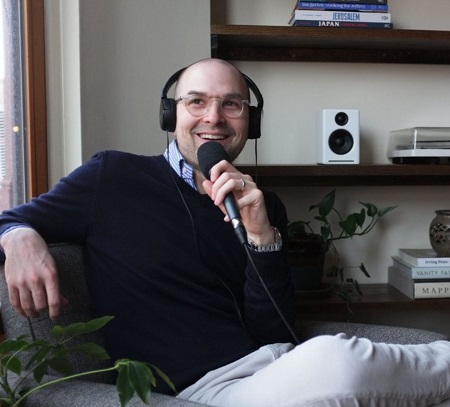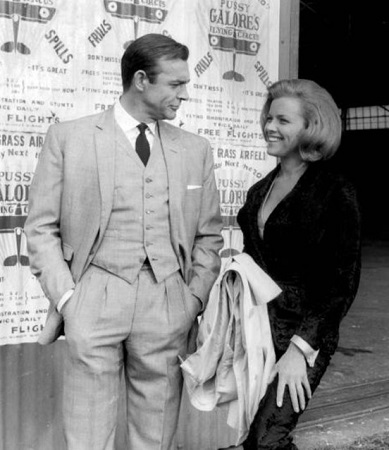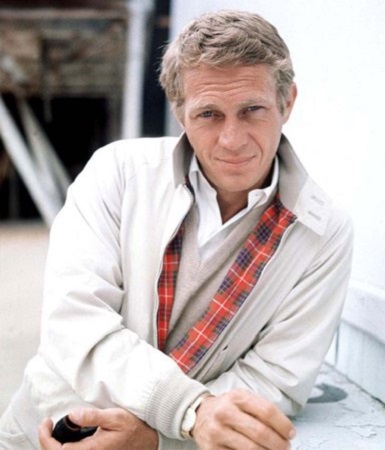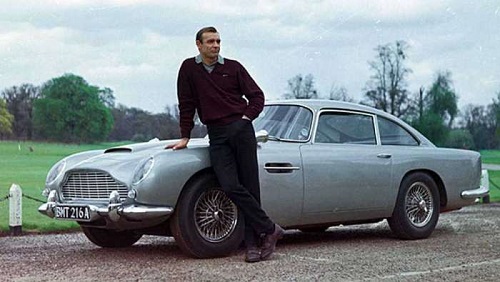Men’s Style Icons and Luxury: A Discussion with Jeremy Kirkland
As fans of Bond and McQueen style, it’s easy to find ourselves so caught up in the clothing that we never stop to ask ourselves why we look to these style icons for inspiration. What is it about their style that we find so appealing? Do we really need to invest in the luxury pieces to find satisfaction? How are the brands using their image to shape our perceptions?

Introducing Jeremy Kirkland
I sat down with Jeremy Kirkland, host of the BLAMO! podcast, to discuss these topics and more. If you’re interested in men’s style and you’re not listening to BLAMO!, you’re missing something really special. Jeremy has interviewed many of the biggest names in the world of fashion, from the contemporary designers we know and love like Oliver Spencer, Paul Smith, Todd Snyder and Billy Reid to the titans of British tailoring like Edward Sexton and Anda Rowland. The list of incredible guests just goes on and on: Nick Wooster, Jim Moore from GQ, Nick Sullivan from Esquire, celebrity stylist Ilaria Urbinati, Bruce Pask from Neiman Marcus, Michael Hill from Drake’s, photographer Jamie Ferguson. You get the idea.

I’ve learned something new from every one of Jeremy’s shows. He asks the questions we’d ask if we ever had the chance to sit down with our favorite designers, business owners and personalities. His interviews are often funny, sometimes serious and always informative. And along the way he’s become something of a curator of great insights into why men dress the way we do. In other words, he’s the perfect person for a discussion about our relationships with style icons and luxury today.
Our Discussion with Jeremy
You’ve had the opportunity to interview many of the most influential people in the world of men’s style. From all of those discussions, have you been able to identify any key takeaways or lessons learned? Do they have anything in common in terms of they way they approach style?
This may sound kind of trite, but the big lesson I’ve taken away is that the most important thing in our lives is acceptance. And the easiest way to telegraph to the world who we are is through our clothes.
But the happiest people I’ve met aren’t the ones who are obsessing over brands. It’s the people who feel confident in what they’re wearing without letting themselves be defined by the labels. They just understand that the way they dress can make them feel a certain way. So they wear what makes them happy, and that affects their attitude and how they carry themselves. That’s where their style really comes from.
And it can be tough with clothing because so much of the fashion industry is about who’s going to be allowed into the club. What’s acceptable and what isn’t.
That’s something I think a lot of men find confusing right now. The “rules for how to dress” were already changing before COVID. And now we’re coming out of lockdown and guys are being told it’s okay to wear sweatpants and sneakers everywhere. But even there, fashion demands that they be the “right” sweatpants or the “right sneakers” if you want to be accepted.
And that’s why the happiest and most stylish people I know don’t let themselves be defined by the “right” objects. Because they know those are always changing and fleeting.
It’s really common to feel that if you can just get a certain suit or the “right” watch, then that will be the thing that makes you feel like you’ve made it, that you’re going to be accepted and you’ll finally be satisfied. And maybe they do make you feel that way for a bit. But my closet is filled with suits that all ended up just being regrets in the end. That’s not the fault of the suits. They were amazing steps on the journey and I’ve enjoyed experimenting with seeing what’s worked for my personal style. But none of them are things I turn to now thinking, “This is going to make me feel good today!” Because it’s not only fashion that’s always changing. We’re also changing and evolving, trying to grow. So I look at some these things I’ve bought in the past and wonder, “What was I thinking?” They’re just not right for me today.

For me, it’s interesting how this pursuit of the next “right” thing relates to our admiration of style icons. Many of us see Bond or McQueen wearing a certain jacket or shirt or a pair of boots and we think, “If I get that thing, then my wardrobe will be complete and I’ll finally look like my style hero.” Of course it never works out that way, and there’s always the next thing to get.
The funny thing is not many of those classic style icons obsessed over clothing the way the people that want to dress like them do today. For one thing, as Bruce Boyer says, their options were much more limited at that time. Go back sixty or seventy years, and the number of stores selling men’s clothing was just a fraction of the number that we have now. So many of those actors were shopping at the same stores or visiting the same tailors and shoemakers.
A more interesting question might be: why is society in 2021 still idolizing the same six or seven classic style icons that lived decades ago?
Well, personally, I think one of the reasons is because men do have so many options today. It gets confusing. So it’s easier just to revert back to a socially acceptable archetype of “masculine style” and say, “I want to look like that”.
That’s probably part of it. Sid Mashburn said, “Men need the right options, not every option.” But today we’re surrounded by so many options we just don’t know how to decide. There’s also a nostalgia mentality that’s important. We can look back at these men and the way they dressed and it seems like they had it all together. Their different looks have been cataloged and established. And that gives us a sense of security and safety that we want, especially now with everything that’s been happening.

But I also wonder if our continuing fascination with the style icons of the past means we just won’t get another Gary Cooper. Or to look at it another way: if you were transplant Steve McQueen from the 1960s to 2021, what would he be wearing today? Would we even consider a modern McQueen to be a style icon?
I think some of the answer to that question connects with how we approach luxury today. McQueen, Cooper, Cary Grant and Bond are icons because, in one form or another, they represent an idealized version of men’s style. And that often included an idealized version of the luxury lifestyle. But have our feelings about luxury changed over time?
Can we even agree on what a “luxury clothing brand” is anymore? I think it’s easier to define luxury when it comes to things like jewelry, watches and cars, simply because of the dynamics of those markets and the limited availability of the products. And the brands operating in those areas still represent something to the people that see you wearing them. The car you drive or your watch are easy to identify and can make a statement about who you are.

But I think when it comes to clothing, the concept of “luxury” is quickly fading. We’re at a point where I can get Thomas Mason cloth and have my shirt made at a place in New York, or I can use an on-line MTM service like Proper Cloth that manufactures in Asia, or I can go and have it made by a shirtmaker in Naples. So if it’s exactly the same cloth and I can get a custom shirt with about the same fit at all these different price points, where does the “luxury” come from? I could walk into a room wearing any of those shirts and most people couldn’t tell them apart.
And luxury used to be about more than just the price. There was that element of exclusivity. A large part of what made something a “luxury item” wasn’t only that you could afford it. You also had to be able to get it, and availability and access were often limited. Now we can buy a discounted Gucci sweater online with just a couple of clicks.
Exactly. So how are we supposed to know what luxury is today? Heritage luxury brands are left with only a few options. They can create scarcity: if their products are rare that increases the value. They can vertically integrate, like Loro Piana or Brunello Cucinelli, so they control the supply of their raw materials, the manufacturing and the final products. Or they can invest a whole lot of money in marketing to tell you that they’re “luxury”. Pay to get their clothes on the right people, or in the right movies, advertise in the right magazines or at the right events, etc.
The relationship between the classic style icons and the luxury brands wasn’t exactly like that in the past. For example, people are still arguing about who made Cary Grant’s sunglasses in North by Northwest. But if that movie was made today, the sunglass brand would probably have to pay a lot of money to have Grant wear their glasses. And then they’d have a whole marketing campaign about it and that model would be advertised everywhere.
![]()
But if the luxury materials are becoming a commodity in the eyes of many customers and it’s all about the race to spend the most money to get your product in front of the most eyes, what are luxury brands adding to the equation to differentiate themselves?
It’s coming down to this: who is the best storyteller. That’s all it is. And I don’t say that lightly. Because anyone can make a shirt. But if you can tell a story and build a world around that shirt that people want to be a part of, then you’re doing something special.
Storytelling is what the traditional luxury design houses did so well. There aren’t many people that could point to a Louis Vuitton bag and tell you what season it’s from. But Louis Vuitton didn’t worry about that. They focused on building the world in which that bag exists. The yachts, the private planes, the travel. The quality of the product certainly matters. But the story of the lifestyle, when they show you where you can take that bag and how you can get there, is what makes it luxury.
The best new luxury brands are doing the same thing. They’re investing in the quality of their products and the designs. But they’re also investing in that world building and working to protect their stories. And it’s a very difficult task, especially today when there are so many brands trying to do exactly the same thing.
I think this may be one area where a smaller, more boutique luxury brand may have an advantage. Larger luxury brands have to sell more to support their business infrastructure. So their story needs to appeal to a large segment of the market. But a smaller brand can be more flexible and create a story that appeals to a specific niche.
Well, the market is definitely more segmented than ever. If you ask a 15 or 20 year old to define luxury, he might say a rare Nike colorway or the most recent Supreme drop. Maybe the product itself isn’t very high end. It could be t-shirt or a pair of sneakers. But the scarcity, and what that scarcity does to the price, makes it a luxury product in his mind.
So yes, we’re certainly approaching a point where each demographic could have it’s own luxury clothing brands and no two groups would agree on what those are. And smaller companies can take advantage of that.
But I also think these newer, smaller luxury brands need to find a size where they can be content. Not every company has to grow and become a billion dollar brand that sells to everyone. You can have a lot of success as million dollar brand serving your niche. It’s one of the reasons I like brands like Noah or shops like C’H’C’M’. They’ve found the size that works for them and they’re happy with that.
And that smaller size also let’s them have a closer relationship with their clientele.
Yes. Another thing that matters to me when we talk about luxury is the idea of the acquisition journey. Brands spend all this money on customer acquisition, marketing and advertising, trying to capture a share of the market and shape the customer’s perception about the value of their products. But the acquisition journey is from the customer’s point of view. It’s about how he forms a personal relationship with the brand on the way to buying the actual product. When a brand has a great product and a great story and can make that acquisition journey an important part of the customer’s overall experience, they can really deliver a feeling of luxury.

For example, Audemars Piguet knows they have a supply issue. And they actually don’t want to sell every person in the world a Royal Oak. They’re limiting that. So they’ve set a really high bar for acquiring that watch. That means their advertising doesn’t tell you where you can buy one. Instead it focuses on consistently reminding you why they’re the best, why they’re desirable. So when you do cross that bar and finally get a Royal Oak, people are going to immediately know what it means and what it says about you. How many luxury brands still really offer that kind of experience?
Any last words of wisdom you’d like to share?
I’ve been reading a biography on Bob Dylan and I’m astonished by how little he thought about what he wore. He just didn’t care. He was absurdly wealthy and he’d still go out and buy stuff off the clearance rack at Sears. He just had the attitude that, “Me wearing this is what will make it cool.” And he was right! In the end, it’s always about the person. It’s always about how you feel wearing the clothes and how they fit with your story.
A special thanks to Jeremy for taking the time to speak with us. You can listen to all the episodes of the BLAMO! podcast here or on Apple Podcasts or Spotify. And to stay up to date on his latest guests, you can find Jeremy on Instagram at @blamopodcast and @thekirkland. For more inspiration to help you develop your personal style, check out our series on How to Dress Like Bond.
I really enjoyed the interview. Thanks to this website, The Bond Experience and a few other things, I have understood in the last few years that it isn’t what you spend on an item, but the way that that item makes you feel. I have a few Bond tie in pieces from some of the brands, but, I also have items that are a tenth of the price or even less and if they fit well, make you comfortable and give you a sense of personal pride that is what matters. Just wanted to say thanks
Thanks James! I’m glad you enjoyed the article. Jeremy really knows his stuff and it was great to be able to share some of his insights. Cheers!